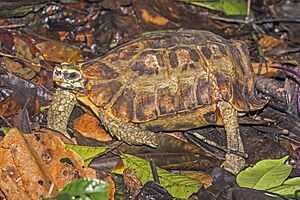Home's hinge-back tortoise facts for kids
Quick facts for kids Home's hinge-back tortoise |
|
|---|---|
 |
|
| In Kakum National Park, Ghana | |
| Conservation status | |
| Scientific classification | |
| Genus: |
Kinixys
|
| Species: |
homeana
|
The Home's hinge-back tortoise (Kinixys homeana) is a special kind of tortoise. It belongs to the Testudinidae family, which includes all tortoises. This tortoise is found only in Africa, meaning it's endemic to that continent. It's known for a unique hinge on its shell, which helps it protect itself!
Contents
What's in a Name?
The scientific name for this tortoise, homeana, was given to honor a famous English surgeon and naturalist named Everard Home. He was a scientist who studied nature.
Where Do They Live?
Home's hinge-back tortoises live in several countries in Africa. You can find them in places like Benin, Cameroon, the Democratic Republic of the Congo, Equatorial Guinea, Gabon, Ghana, Guinea, Ivory Coast, Liberia, and Nigeria. They might also live in Togo.
Their Natural Home
These tortoises love warm, wet places. Their natural habitats include tropical forests with lots of moisture. They also live in tropical swamps and even in plantations, which are large farms where crops are grown.
Daily Life of the Tortoise
Home's hinge-back tortoises are quite interesting! They are naturally drawn to red or pink flowers. They prefer areas with low light, so you'll often see them moving around in the early morning or at dusk. During the rest of the day, they usually stay hidden to keep safe.
What Do They Eat?
In the wild, these tortoises eat different plants and possibly small animals. When they are cared for by humans, their diet can include many yummy things. They enjoy fruits like banana, guava, and watermelon. They also eat black mushrooms, cooked sweet potato, cooked potato, and cooked or raw squash. For protein, they might eat earthworms, mealworms, crickets, snails, and even fish!
Protecting This Species
Sadly, the Home's hinge-back tortoise is currently considered a threatened species. This means their numbers are decreasing. The main reason for this is habitat loss. Their natural homes, like forests and swamps, are being destroyed or changed by human activities. It's important to protect their habitats so these unique tortoises can continue to thrive.


